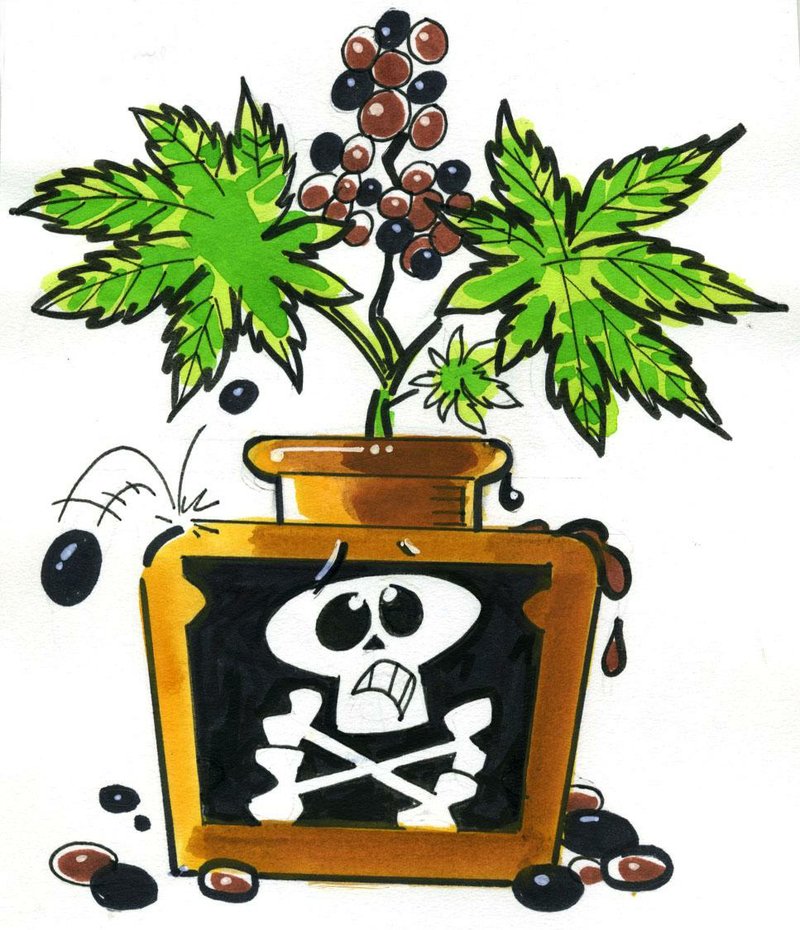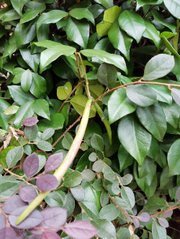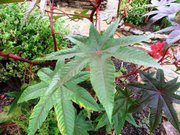Q This plant came up voluntarily and is 7 feet tall. Do you know what it is? Do I want it?
A The plant in question is a castor bean -- Ricinus communis. In spite of the huge size it attains in one growing season, it is an annual that will die after a killing frost. It can come back from seed, which is how you got yours -- a bird shared it with you. All parts of the plants are toxic, but the most dangerous are the seeds. The seeds are what is used to make castor oil, but also the highly toxic ricin. Many gardeners grow castor bean as an ornamental or to help deter gophers and moles, but it would take a perimeter planting to keep the animals totally away.
Q I'm retired with a small yard and lot of shade. I have a small, raised bed in full sunlight where I raise a few tomatoes. Last year they did well, this year they grew to 5 feet staked and then blight hit them. I know you're not supposed to plant in the same spot every year, but I have no other area in full sun. Is there any way to treat soil to get rid of blight over the winter? Or must I change out the soil in bed every spring?
A Many people struggled with tomatoes this year, but planting in the same spot will make your problems occur earlier each season, as many tomato diseases are soil-borne. You have a couple of options. If this is the only bed you can plant in, you can solarize at the end of the season -- but you would have to do so by late August to early September. Solarization requires high temperatures. You till the soil, saturate it with water and then cover with clear plastic for six weeks.
July-September are the best months to do this. You could also try planting a cover crop in the fall. Mustard greens are one that has shown promise with deterring soil-borne diseases. Again, it is getting a bit late in the season, but if you can find some mustard plants at your local nursery, give it a try. Your saving grace is that it is a raised bed, so you could replace the soil. But that is a hassle. I would also consider constructing another raised bed or two and alternating what you grow. Good luck.
Q Recently I had a local nursery install several plants at the back of my condo in Russellville, consisting of "Sky Pencil" holly, "Soft Touch" holly, Knock-Out roses, camellia, a "Teddy Bear" magnolia, and a Japanese lace leaf maple along with some Encore azaleas and Distylium. My question is should I fertilize these plants now, and if so, what type of plant food would be best?
A Never apply fertilizer this late in the season. You want the plants to go dormant, not put on new growth as they head into winter. Do pay attention to water needs, as we continue to be quite dry. Pay particular attention to watering when the weather does get cold.
If plants are too dry heading into a hard freeze, they are more prone to winter damage. The key for you is to get the roots established this winter and worry about fertilizing when they are kicking into new growth in April or May.
Q This vine has beautiful, small, white, fragrant blossoms in the spring and these pod things in the fall. When the vine is cut, there is a milky white substance as a sap. Last winter, the ice pulled the vine away from the wall, and we've had no success getting it to reclimb. Our thought is to prune it back severely and install a trellis. Is now a time we could do that?
A I adore this plant. It is commonly called Confederate jasmine -- Trachelospermum jasminoides. It is not a true jasmine, but the blooms are so fragrant that it is called one. This plant does not grow easily on a brick wall without some type of support.
Your plant is obviously healthy and happy, but do not prune it until after it blooms next spring. Pruning now will remove your spring blooms. You can use a trellis or install some masonry nails and fishing twine to give it something to grow on so it can cover the wall. For years we struggled getting this plant to survive the winter, but for the past 15 or so it has done well. I have it on a brick wall in full afternoon sun and have had no damage to it.
DEAR READERS: The Arkansas Master Gardener 2017 gardening calendar includes monthly gardening tips and outstanding photos shot in state by Arkansas Master Gardeners. To order a calendar, call Holly Beason at (501) 671-2237. You can have one mailed to you for $3.50, or you can buy one in person for $1 at the University of Arkansas Cooperative Extension Service state headquarters, 2301 S. University Ave. in Little Rock.
Janet B. Carson is a horticulture specialist for the University of Arkansas Cooperative Extension Service. Write to her at 2301 S. University Ave., Little Rock, Ark. 72204 or email her at
jcarson@arkansasonline.com
HomeStyle on 11/12/2016


